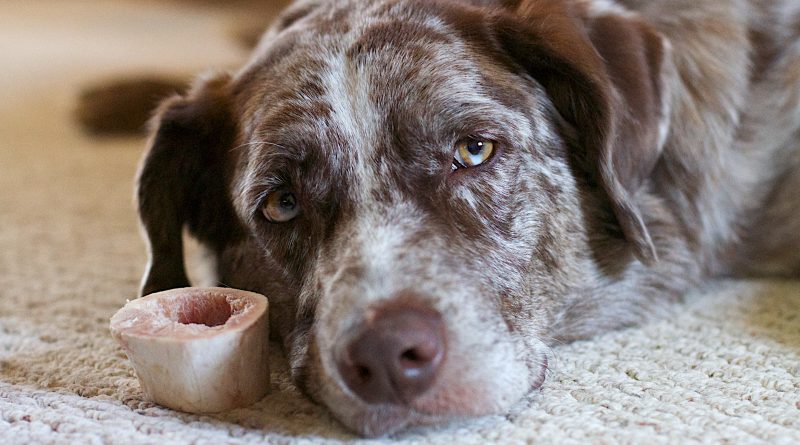Give a Dog a Bone: How to safely feed bones to dogs

“With a nick-nack patty whack, give a dog a bone….”
Bones have been associated with dogs for as long as we can remember. In former times, dogs mostly lived outdoors and off of the table scraps provided by their master. This included both discarded cooked and raw bones. Dogs are also notorious omnivorous scavengers, picking meat and bones from carcasses wherever they roam. I’ve even had my own dog scavenge a discarded fried chicken bone from the side of the road!
In our modern lives, dogs have gone from yard ornaments to beloved fur babies cuddled up in our beds. With this inclusion into the family came an easier, more shelf-stable and balanced form of nutrition – commercial pet foods.
Back to the Roots
While commercial pet foods are recommended most by veterinarians and veterinary nutritionists, some people are wanting to feed their dogs in a more ‘natural’ or ‘holistic’ way.
Many dog owners are interested in cooking at home for their dogs. Many times, this is out of concern for where their food is coming from, their dog’s particular medical needs, or simply including their dogs in a whole-foods, organic lifestyle.
Your Dog Will Gladly Chew on a Bone…but SHOULD She?
No self-respecting canine would turn down a tasty bone. But just because you can feed your dog bones doesn’t mean that you should. While dogs will eat bones “in nature,” this also puts their health at some risk.
Most chickens, cattle and pigs are slaughtered at a very young age in most Western countries. This means that their bones aren’t as hard as in older animals. These bones are more likely to splinter when chewed upon, creating sharp fragments that can cause irritation, choking or even a digestive obstruction. Some dogs get so excited after being given a bone that they will simply swallow it whole, potentially causing a deadly intestinal blockage.
The hard matrix of the bone can pass through your dog’s system, if in small enough fragments, BUT – they may leave a path of discomfort and illness in their wake.
Veterinarians urge pet owners to NOT feed their dog bones for the following reasons, as bones can increase the chances of:
- Choke
- Digestive irritation
- Vomiting
- Diarrhea
- Pancreatitis
- Digestive system blockage
- Digestion system perforation
- Broken teeth
You may be surprised to find that your dog can break its teeth chewing on bones. This is most commonly seen with some of the harder bones, such as beef femur bones. Bones are extremely hard and dogs can put a lot of force into their bites. The enamel on their teeth doesn’t hold up so well to these forces, potentially causing pain, infection and future loss of a tooth…or expensive veterinary dentistry costs.
So, how can I feed my dog bones…safely?
If you are adamant about feeding your dog bones, there are some ways to do so safely.
Bones are sometimes included in food therapy treatments and in Traditional Chinese Veterinary Medicine (TCVM). The majority of the time, these bones are cooked and not fed whole.
Using these sorts of techniques, your dog can benefit from the nutrition found in bones while avoiding some of the risk. Let’s break it down a bit further:
Bone Broth
Bone broth is all the rage for humans following a ‘Ketogenic’, ‘Paleo’ or a ‘Whole 30’ diet or lifestyle. Dogs can partake in some of the broth as well, if you follow certain parameters.
The best kind of bone broth is made from large marrow bones. The bones of the body that contain the most bone marrow are the humerus and femur. Beef femur bones are easy to come by and relatively inexpensive. Your butcher can cut them up into pieces that will fit in your stock pot or pressure cooker.
Bone Broth Recipe
Ingredients
- 2-3 pounds of beef femur, oxtail, beef or lamb shank or chicken bones (it is ok to use a mixture of bones)
- 2 carrots, roughly chopped
- 3 stalks of celery, roughly chopped
- 1-2 tbsp vinegar
- Water
- a few pinches of salt
*Do NOT add onion or garlic to broth recipes for dogs. Onions have a toxic component that causes illness in dogs.
**Don’t omit the vinegar. According to Dr. Patricia Baley, a respected holistic veterinarian in Texas, the vinegar helps to solubilize the calcium and phosphorus in the bones.
Using a pressure cooker, stove-top soup pot or slow cooker, add in all the ingredients and cover with water.
If using a pressure cooker, cook on high pressure for 40 minutes.
If using a slow cooker, cook on high for 6 hours, then reduce to low and continue for another 8 hours.
If using stove-top, bring everything to a boil and then simmer for 6-8 hours.
Strain all the bones and vegetables and discard. Allow the broth to cool to room temperature before serving.
Benefits of Bone Broth
Bone broth is commonly recommended for pets that are recovering from surgery or from a long illness. Many cancer patients can only stomach something as simple and bland as bone broth. The broth holds a decent amount of fats, protein, vitamins, and benefits.
Cooking bones in water helps to release other beneficial compounds. Glucosamine and chondroitin sulfate are released from the cartilage and as mentioned previously, some calcium and phosphorus are also released. For centuries, the Chinese have used bone broth as a remedy for arthritis – no wonder, considering that science now knows that glucosamine and chondroitin sulfate can help alleviate the pain and inflammation of mild arthritis.
If you are able, it is even more beneficial to make a combination of fish and beef broth – using cartilaginous fishes like shark or the more eco-friendly New Zealand green-lipped mussels, as they contain a good bit of beneficial collagen, glucosamine and chondroitin sulfate.
What about the bone marrow?
Cooked bone marrow has some nutritional benefits. It should, however, be fed in very, very small portions due to its high fat content. Pets that are prone to digestive upset or pancreatitis should not be fed bone marrow. Once the femur bones are cooked and cooled, it is easy to scoop out the jelly-like marrow from the center of the bone.
The Doggy-Bag
The best take-away from this is to NOT feed bones that are raw, smoked or whole in any form. The safest and most nutritionally beneficial way to get the goodness out of bones is to boil them first. I bet that your furry friend will enjoy their ‘soup’ just as much as you do.



